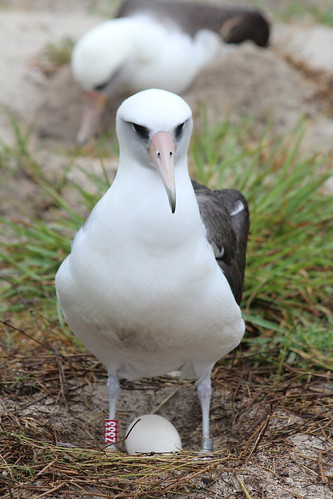 |
| Miranda Zaic, an employee at Wild Birds Unlimited, with Henry in 2014. Photo by Bob King, the Duluth News-Tribune |
From the start, Bob and Lois kept their pet cockatiel, Henry, in the store with them. They didn’t need a bell to notice that a customer had walked in the door—Henry’s sweet call was just as effective and much more welcoming. He and I quickly became friends—he’d often fly straight to my shoulder the moment I said, “Hi, Henry!”
Over the years and then decades, as management and employees and even the store location changed, Henry was the constant. He liked when I bought mealworms—I’d open the container at the counter and let him take one out to eat. And he especially appreciated when I started chatting with Lisa or Paul or whoever was at the counter—if he finished up his mealworm while I was still there, I’d let him take a second.
I was heartbroken to learn that Henry died on January 26 at the age of 27. He will be sorely missed by everyone who knew him.
 |
| Wisdom's mate Akeakamai with their new chick. Photo by Bob Peyton, USFWS |
Albatrosses don’t feed on land, so parents must take turns heading out to sea to eat; one must be with the egg at all times to incubate and protect it. That’s how Wisdom and Akeakamai spent the past two months, each bird spending days or weeks out on the ocean as the other bird fasted and incubated. Now that the chick has hatched, parents will take turns making quick excursions to grab food while the other protects the baby. The parents are both eating for two—when one returns, the chick nibbles its bill, which stimulates the parent to regurgitate stomach oils down the baby’s throat--the returning parent will feed the chick several times within less than an hour. The chick averages more than one of these sets of feedings per day. As it get bigger and stronger, semi-digested food supplements the oils in the regurgitated food, but throughout, the main food the chick eats is that oil. When the chick is big enough to maintain its own body temperature, parents can both be out at sea at the same time; at this point, the parents can wander a bit further from shore, but each one averages returning to the chick every day or two.
The little chick wanders about a bit but must return to the nest in order to be fed. Scientists believe that the adults don’t specifically distinguish their own chick from others until it’s about 6 or 7 weeks old—up until then, if a strange chick wanders into a bird’s nest, it may get fed in place of the parents' own chick. Because the flight to sea and search for food are time- and energy-consuming, scientists believe that it’s impossible for albatrosses to successfully rear two chicks, or for one parent to bring off a chick if it loses its mate.
Fortunately, as one 68-year-old mother can attest, albatrosses are long-lived. The reason we still have any at all on the planet is because both parents do usually survive to faithfully return to the nest while there is a dependent chick. As the baby gets big, the parents come a bit less frequently, and one day they stop returning. At that point, the chick still has plenty of fat to live off for a while. Hunger and basic instinct lead it to the shoreline, and one day, off it takes, ready to lead the life of an albatross. Since 1956, we know that Wisdom has successfully brought off at least 30 fledglings. In 2019, it's thrilling to know she's on her way yet again.
